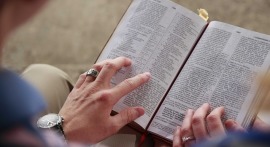
According to one Bible scholar, a recent finding of a brass sculpture of a dinosaur-like beast adorning a 500-year-old tomb in an English cathedral proves that dinosaurs once roamed the Earth alongside humans, destroying the hypothesis of evolution.
According to a report from the Express, scientists reportedly believed that dinosaurs ruled the Earth for 66 million years. "Young Earth Creationists," however, have presented a different theory based on some interpretations of Biblical Chronology. They claim that the planet's age may be determined by tracing the lineage of mankind from Adam and Eve's creation in Genesis to the birth of Jesus Christ in the New Testament.
Young Earth Creationists believe the earth is just 6,000 to 10,000 years old, which contradicts the geological estimate of 4.543 billion years. But how does this align with the fossil record and the dinosaurs that scientists say perished millions of years ago?
Tom Meyer, a Bible studies professor at Shasta Bible College and Graduate School in California, believes that there is definitive proof supporting the hypothesis that dinosaurs roamed the Earth at the same period as humans - evidence that he argues refutes Darwin's theory of evolution.
Meyer, also known as the "Bible Memory Man," suggests that the brass carving of a dinosaur-like beast adorning the tomb of an English bishop buried in the Middle Ages - more than 300 years before paleontologists invented the word "dinosaur" - is hard evidence. It's the tomb of Bishop Richard Bell which was discovered in 1496 on the floor of the famed Carlisle Cathedral in England.
"Startling evidence has come to light which demonstrates that English artisans had knowledge of what dinosaurs looked like as far back as the end of the Middle Ages," Professor Meyer said.
"His tomb was elaborately decorated with brass engravings depicting all sorts of animals contemporaneous to his time such as a bat, dog, pig, fish, eels, etc. But found among all these real and, to this very day, common animals, are depictions of two other real animals: dinosaurs," he explained.
The Express states that at first sight, the dinosaurs resembled the Brachiosaurus and Brontosaurus- members of the sauropod family - which had four-legged bodies and lengthy necks and tails.
"Sauropods are a group of dinosaurs that had very long necks, long tails, small heads, and four thick, pillar-like legs. They are famous for their sheer size, being among the largest animals to ever roam the Earth," said Meyer.
The professor argued that the early artisans for these dinosaurs would not have based them on fossils or skeletal reconstructions.
"If dinosaurs became extinct 77 million years before man evolved on the earth, how did these English Middle Age artisans know how to accurately depict them?" he pointed out. He goes so far as to claim that some of the brass etchings resembled the stereotypical Vulcanodon dinosaurs.
The second carving, according to Meyers, looks much like a Shunosaurus which paleontologists have only been able to locate in the Sichuan Province of China. The accuracy in the detail of the artisans' dinosaurs suggests that they have seen them in their lifetime.
"The engravings upon the tomb of Bishop Richard Bell and biblical chronology contest the conventional wisdom that dinosaurs became extinct 77 million years ago, well before man evolved via a series of chance mutations over billions of years," concludes the professor.
"The evidence matches the biblical belief better than the evolutionary belief, "he added.
This video from the Institute for Creation Research, posted years ago, shows how the carvings look like:




























